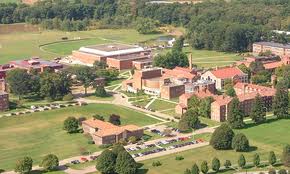By: Zach Waltz
Assistant Sports Editor
Millions of high school seniors make an important decision – perhaps the most important of their lives – to attend an institution of higher learning each year.
According to the U.S. Department of Education, there are 2,364 colleges and universities offering a four-year education. College populations can range from under 1,000 students to more than 30,000. According to collegeprowler.com, there are 1,751 colleges and universities that have fewer than 5,000 students. These schools are considered to be “small” schools.
There is always debate over whether attending a small school has more benefits than attending a large school, or vice versa. St. Bonaventure has 1,908 students enrolled, making it fall into the group of small colleges.
The benefits of attending a small school largely outweigh the benefits of attending a big school.
The largest difference between big and small schools is class size. At a large school such as Penn State, some lectures can contain more than 300 students per section, according to the school’s website. The classes are held in giant auditoriums, void of the intimacy that is offered by a traditional classroom. The majority of classes at St. Bonaventure contain less than 20 students to a class, according to usnews.com, but I’ve even had a Clare College course with only 10 students in it.
Personally, I would rather interact with a professor and maybe even get some one-on-one attention as opposed to sitting in a dark auditorium and taking notes from a PowerPoint presentation with no professor in sight. Who would want to go through that torture? I find it hard enough going to class as it is.
Another leg-up that small schools have over large schools is the dedication of the professors, according to usnews.com. At St. Bonaventure, professors are committed to helping students succeed and go out of their way to help a struggling student who asks for help.
At a large school, you can’t just walk to the front of your lecture hall and speak to the professor who may or may not even be there. This sort of bond between student and teacher is easier to make when the class size is smaller.
So why do people choose to go to a large school?
A large school can offer networking pretty much anywhere you can imagine. Schools like Penn State or Ohio State just pump out clones with bachelor’s degrees. So naturally, many graduates turn out to be successful in whatever they choose to pursue. However, those networks don’t always hold up, because a CEO from Penn State can’t just hire the entire graduating class. A Penn State degree is almost like a belly button at this point – everyone has one.
That’s why, even in this aspect, a small school can still be better than a large school. Networking at St. Bonaventure almost always comes through because we have a tight-knit alumni base that is willing to at least consider hiring a fellow St. Bonnie’s graduate.
Even though a large school may have more connections, a small school’s connections are more likely to actually get you a job, which is what we all go to college for anyways, right?
While small schools cannot compete with large schools in the quantity of graduates, the quality of education offered by a smaller school far outweighs the quality offered by a larger school.
waltzzd12@bonaventure.edu








